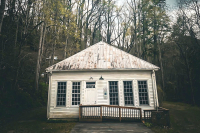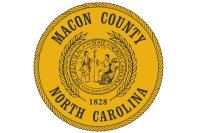A new model of health care: Cherokee celebrates new hospital
 After a week of rain, the sun rose brightly over the new Cherokee Indian Hospital and the crowd attending its opening day.
After a week of rain, the sun rose brightly over the new Cherokee Indian Hospital and the crowd attending its opening day.
And while the traditional music, dancing and prayers that characterized the celebration might not be elements of a typical ribbon-cutting ceremony, the new hospital is not a typical health care facility. But that is what the Cherokee people gathered there Oct. 15 were most proud of.
“It’s going to give a sense of comfort and well-being and help with the healing process,” said Principal Chief Patrick Lambert. “The healing begins the moment you walk in the door.”
“I’m overwhelmed with joy right now,” added Tribal Council member Adam Wachacha, of Snowbird.
At 150,000 square feet, the new hospital is nearly twice the size of the existing 80,000-square-foot building. It cost $82 million to complete, and services will expand to include specialized dental services such as pediatrics, an endodontist to do root canals and other procedures, more access to oral surgery and improved imaging; outpatient procedures like colonoscopies and endoscopies; a drive-through pharmacy; expanded radiology services using new MRI and CT scan machines; eye care; hospice and improved physical therapy.
Those stats in themselves are impressive and worthy of celebration, but hospital leaders made it clear that the new facility represents more than just an expanded inventory of services and that new-building shine. The facility’s opening signals a paradigm shift in how health care will be offered on the Qualla Boundary.
Related Items
“Integrated care is what a lot of people think is going to be the future of health care,” said Brad Letts, a member of the hospital’s board of directors.
“Integrated health care” basically means designing the hospital around the patient’s needs, arranging things so people who come for treatment aren’t sent scurrying from floor to floor on a wild goose chase for the correct specialist to address their problem. Rather, medical staff is arranged in teams, each of which includes a doctor, nurse, dietician, psychologist and pharmacist. Those people all share a workspace, working collaboratively to address the patient’s needs. The hospital will hold six such teams, each of which will be responsible for somewhere between 1,100 and 1,200 patients.
“It’s a team approach,” said Francis Owle Smith, a member of the governing board and herself a doctor. “Doctors don’t have offices anymore.”
It took years of research to arrive at the model and figure out how that approach should translate into physical building plans. A group of hospital leaders traveled all the way to Alaska to tour the facilities that had the strongest influence over how the Cherokee Indian Hospital turned out. The Southcentral Foundation, a nonprofit healthcare organization that serves nearly 65,000 Alaska Native and American Indian people in Alaska, operates on the Nuka system of care, named after “an Alaska Native word used for strong, giant structures and living things,” according to the foundation’s website. It’s a relationship-based system that seeks to make medicine, tradition, infrastructure and organization work together for the best health outcomes.
“The Nuka system of care is based on the premise that patients get healthy when they have a healthy partnership and relationship with their team,” explained Casey Cooper, the hospital’s CEO.
The physical environment is also a significant component of the philosophy.
“We spent a whole lot of time and money focused on environmental engineering, where to locate things,” Letts said. “Do you want people walking two, three stories who need physical therapy? No.”
That’s why the building is long and lean instead of big and boxy. It’s strung out across multiple, connected structures, allowing numerous points of entry to increase ease of access. The long design also allows for angled gaps in the building sections — Letts describes them as orange slices — to maximize the number of rooms that have windows. Of course, that kind of construction is more expensive than the straight-up box design, but one of the beliefs driving the building layout is that beauty and sense of place are important components of wellness.
“The governing board told the design team, ‘First and foremost make sure you build us a facility that accentuates the natural beauty of the environment we live in, because there is such a strong sense of place among the Eastern Band of Cherokee Indians,” Cooper said.
The interior walls of the building are wrapped with photographs of Southern Appalachian landscapes, and windows take up nearly the entire eastern face, revealing a view of fiery fall mountains. The floor of the first-level hallway mimics a river, with dark blue in the middle, a lighter blue around that and brown at the edges. Outlines of fish and animal tracks dot the way.
Culture and place are intertwined, and the hospital reflects that. Cherokee art and tradition are woven throughout.
“You can always tell how well a culture is doing based on the artwork, and I think this is exemplary of that,” said Lucretia Hicks, patient registration manager at the hospital, as she stood greeting visitors in the main lobby. “A lot of our stories and traditions have been incorporated.”
Photography, paintings, baskets and other forms of art by Cherokee people are displayed throughout the hospital, and as she spoke, Hicks was standing directly on the centerpiece of cultural incorporation — a pattern on the rotunda floor depicting a spider standing in the middle of the water, a flame on its back. The design, which youth from the Junaluska Leadership Council helped create, harkens back to the Cherokee tradition of how fire originally came to Earth. In the beginning, the story goes, there was no fire. Then one day, lightning struck a tree on an island, igniting it. The animals held a council to decide who could bring the flame across the water. Animal after animal tried and failed, until eventually the tiny water spider volunteered. She spun a web into a little bowl placed on her back, walked across the water, and brought back the tiny coal from which all fire originates.
For the Cherokee, that’s not just a story about fire. It’s a story about life itself, because fire symbolizes the force of life that is inside each living thing.
“Everything in creation has that spiritual energy in it that gives it life, that makes it come into being, and it’s all connected,” said Amy Walker, a tribal elder.
Walker is all smiles when it comes to the new hospital, but she hopes the facility will be more than just a place to disseminate Western medicine. She wants to see the hospital act as a bastion of Cherokee culture and its approach to holistic healing.
“If (health care providers) are educated in our culture, I think that is probably the biggest aspect of healing that will really be brought out in this new facility,” Walker said. Whereas Western medicine divvies problems up into the respective domains of physicians, psychologists and reverends, traditional Cherokee healing looks at the whole person to find the root cause of the problem. She’s hopeful that the new facility’s emphasis on place, traditional stories and collaboration among medical staff will help move health care on the Qualla Boundary in that direction.
For tribal member Natalie Smith, the best part of the new facility is the patient rooms. They’re large and sunny and — most importantly — have fold-out beds and wider-than-normal patient beds so family members can snuggle with their loved ones. Two of the 18 rooms connect to rooms that, instead of beds, contain a living room-like space with a sofa, chairs and a table.
“One of the most emotional things for me is to have a room that can accommodate your family,” Smith said. “The beds are big enough to get in so you can love on your family member.”
How is a person supposed to heal, Smith asked, when they’re shoved in a room too tiny to hold the people most vital to their emotional health?
“I think the biggest shortfall of hospitals I’ve ever seen is being forced to be alone because there’s no room for your family to be there,” she said.
Space, light and service — all components of the new hospital and all points of hope and pride for the evolution of health care on the Qualla Boundary. And, possibly, in Western North Carolina as a whole.
“It’s a new model of health care,” said David Belcher, chancellor of Western Carolina University, who attended the ribbon-cutting ceremony. “I think what they’re doing here is unbelievable, and I think there’s a lot other hospitals can learn from what they’re doing here (at the hospital).”
Or, as behavioral health counselor Patty Grant Edgeman put it, “I can’t wait to get sick.”
The road to opening day
The new hospital is actually the fourth health care center Cherokee has had, with the ribbon cut on the existing hospital 35 years ago.
But it wasn’t until 2002 that the Eastern Band of Cherokee Indians took on full ownership and responsibility for the Cherokee Indian Hospital. Soon after that, hospital leaders realized that they’d need to start planning for more space. In 2007, they began looking at expanding the existing facility but found that to be an expensive proposition that wouldn’t fully address the organization’s needs.
That’s when then-Principal Chief Michell Hicks sponsored legislation to fund construction of a new hospital.
Unfortunately, that decision coincided with the recession, and the project was put on hold. In the interim, hospital leaders did their research, looking for a model that worked and traveling to Alaska to see the facility that most caught their interest.
Now, two years after groundbreaking, the $82 million facility is complete and fully tribally owned, with $20 million worth of the work done by tribal members. The hospital will be paid off within 10 years, CEO Casey Cooper said.
“The members of this community are deserving and they are worthy of world-class service in a world-class facility,” Cooper told the crowd gathered for the ribbon cutting. “We are not here today because of the (federal) government’s commitment to health care. We are here in spite of it.”
The opening process
On Monday, Oct. 19, the new Cherokee Indian Hospital opened up its pharmacy, but the launch process is still under way for the rest of the hospital’s services. By Monday, Nov. 16, the hospital will be in total operation. In the interim, equipment will be moved to the new building and staff will finish training in the integrated care model.
“The staff, they’re still in training, they’re still checking out the new equipment and we want everything safe and proper when our patients come to see us,” said Carmelita Monteith, chair of the hospital’s governing board.









